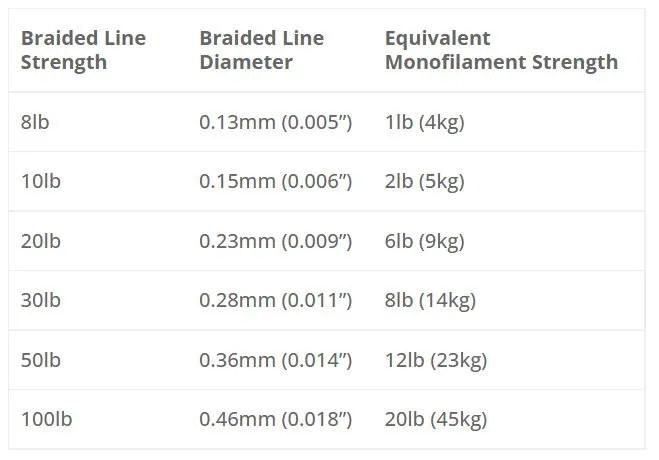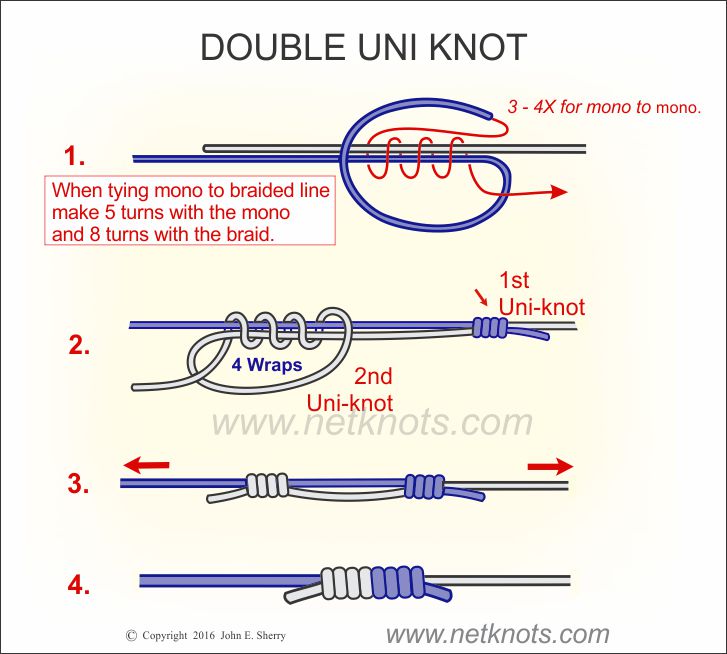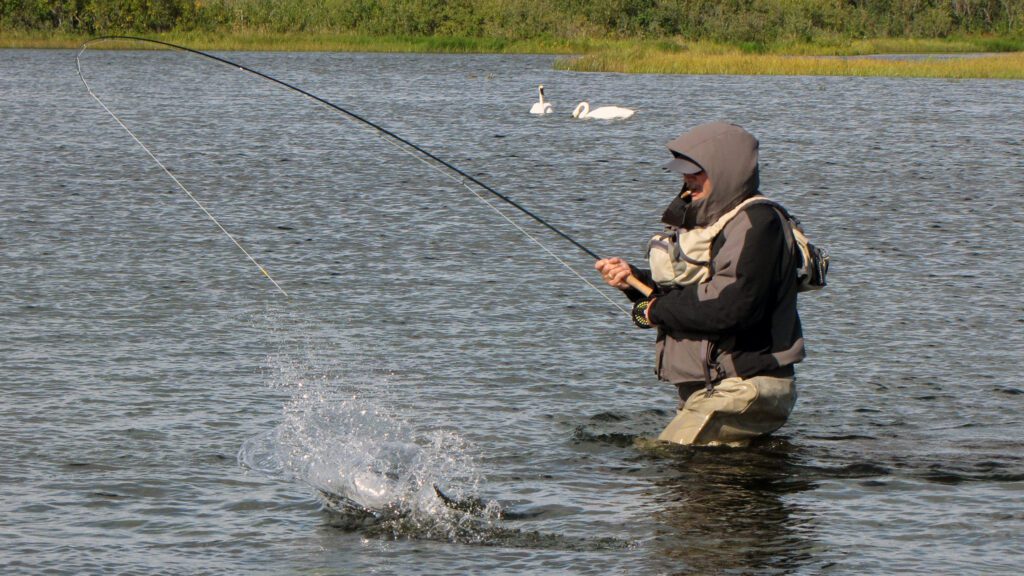When fishing, a braided line can be an excellent choice for many reasons. It is durable and comes in various colors, line weights, and line lengths.
Braided fishing lines can be extremely sensitive, detect every strike from the fish, and are resistant to tangles and knots. A braided fishing line can be more expensive than monofilament, but it has many advantages. Its ultra-sensitivity will detect every strike, and the braided fishing line is thin, cutting through water resistance with no issues.
When you understand the benefits of braided fishing line, you’ll be able to choose which is best for you.
What is Braided Fishing Line?
Braided fishing line is a combination of strands of polyethylene fibers woven together into a single strand. Braid is usually comprised of 4 to 8 strands. Some fishing manufacturers go up to 16 strands, but this is used by anglers in specific use cases such as deep sea fishing for ultimate strength.
Another term used that you have to be aware of is “carrier”. If a braided fishing line has four strands, it may be called a “four-carrier.”
Braided vs. Monofilament

Braid has a much smaller diameter when compared to any monofilament or fluorocarbon fishing line.
Considering spools can only hold a certain amount of line, the ability of braided fishing line to be thinner yet stronger allows it to be used in more fishing applications. Having more line on your spool allows for longer drifts, or when you have to cut your line loose you still have plenty on the spool.
Look at the graph we’ve supplied. You will see that braided fishing line is much stronger per width unit, meaning the small width of the braided line when compared to mono or fluorocarbon is almost 3x the strength.
Advantages of Braided Fishing Line
Strength
The strength of braided fishing line makes it exciting. Want to land a trophy salmon on your favorite run this coming season? Bets are that braided line is your best bet. Nothing is worse than skimping on your line just to have one on the line break off.
No Stretch
Unlike monofilament, a braided line has no give to it. It doesn’t stretch which has great use cases such as when you are running a top-water bait. The amount of foliage can often cause issues for regular fishing line but braided line is extremely strong and will shrug off most issues.
Sensitivity
Because braided fishing line has no stretch, it allows you to feel every bite as if you are holding an ultra-light rod. But be careful because the fish will also be able to feel every twinge of your hand, so be conscious of your lure movement techniques, especially when using a braided line.
Casting Distance
The typical diameter of a braided line when compared to monofilament is approximately 1/3 the size. That means you have more line on the spool and can cast insanely far. Casting distance is a huge advantage in many scenarios when you want to get past the break or need to pinpoint something in the distance without spooking the fish.
Greater Hookup Potential
Because braided fishing line doesn’t stretch, it allows you to be more responsive when something hits the bait or lure you are casting.
Durability
Of course all fishing lines eventually wear out, whether it’s dry-rot or otherwise, but braided line has the potential to last much longer than monofilament or any other type of line.
Disadvantages
Visibility
Braided line is extremely visible compared to conventional fishing lines such as monofilament. This doesn’t matter for some occasions, such as deep sea fishing or top water, but for others, like fishing for notoriously skittish trout, a braided line may not be the best choice.
Expensive
When compared to the mass-market type of fishing lines, braided line is expensive. But that’s obvious because it is better quality and is used for specific use cases where anglers understand their needs and are willing to pay a little more for something that will hold the fish on when they strike.
Harder to Cut
Some might not be used to just how strong a braided fishing line is. So, because of this, some complain that it is hard to cut. But just bring the proper accessories, such as a needle nose cutter, and you will be fine.
Wind Knots
Lower quality braided line can cause a lot of frustration because of the knots it can cause. This also has to do with the fisherman’s ability to control their cast and line, but still, braided line can knot more often than other types of fishing line.
Fouling Line
Sometimes a braided line can foul up the tip eyelet of your rod. This is usually due to two things: the cast specifics of the fisherman and an improper line tied onto the reel.
How to Tie Braid to Monofilament or Fluorocarbon

One of the most popular ways to join a braided line to a monofilament or fluorocarbon is the uni knot. NetKnots does a great job outlining a moving diagram of how this knot works. I’ve included a picture from their website to have a quick glance at the process.
Usually, anglers use a uni knot when they want to tie on a leader to hide the visibility of most braided lines. The term used for this is a shock leader. The leader can be between a foot and six feet usually, which all depends on the kind of fishing you are doing.
A word of caution: make sure to practice any joining knot before getting on the water. Braid has the ability to cut through the other kind of fishing lines if the knot is incorrect.
Our Picks – The Best Braided Fishing Line
Overall Top Pick: KastKing Superpower
The KastKing Superpower Braid has one of the smallest diameter lines compared to other brands. With this, you can spool more line onto your reel, which is great for most applications. It never hurts to have more line on your reel unless you over spool it. This is one of the most popular braided lines across all online websites and it’s no wonder why.
| Pros | Cons |
| -Extremely Affordable -Small diameter when compared to competitors -Great variety of strength & lengths | -Often out of stock -Complaints of color fading over time -Roughness of braid (use on strong tipped rods) |
No products found.
Honorable Mention: Berkley FireLine Superline Fishing Line
The Berkley Fireline Superline is our honorable mention for best-braided fishing line.
It is one of the few braided lines with low water visibility. This, combined with the reputable brand of Berkely, puts it at the top of the heap. The line is also micro-fused with Dyneema PE fibers that are 3-4 times stronger than monofilament.
| Pros | Cons |
| -Brand is a staple in the fishing industry -Low water visibility -Cutting edge technology | -Limited offering of pound test options -Limited length when compared to competitors -Harder to find online |
No products found.
Which Braided Line is Best for Me?
This all depends on your rod and reel setup and what type of fishing you will be doing. For instance, some prefer to run a 4-strand braided line on their baitcasters while tying their spinning setups with 8-strand.
So before we go on, ask yourself: What type of fish will I be going after? What type of rod and reel setup will I be using? And how much experience do I have with braided line?
The answers to these questions will help guide you through the next categories that explain the color, pricing, line weight, and line length.
What is the best color?
A green braided fishing line has very low visibility and blends with most environments. While the yellow braided line is highly visible, moss green will blend better. Both colors work well with a clear fluorocarbon leader.
Some claim that color has no bearing on the viability of the fishing line once it is underwater. This may be true for some species, but I’ve experienced fishing being alerted by my fishing line many times. Trout and salmon are very finicky. Then again, maybe mono is the better bet when fishing for those fish.
If you are super concerned about visibility, use a monofilament or fluorocarbon leader, and your line will be practically invisible to the fish.
Price
The braided fishing line pricing is usually within a range of $10-$30. If you are new to braided line, consider buying something on the higher end to take out the guesswork of “is this just a cheap spool of fishing line?” From there, you can hone your skills and practice with a quality braided line.
Line Weight (aka: pound test)
This is highly dependent on what type of fish you are after. All fishing lines have a line weight associated with their ability to withstand snapping under stress. For example, if you tie a 10lb bowling ball to the end of an 8lb braided line, it may snap immediately. Of course, we’ve all heard stories of people catching larger fish than their line weight may indicate possible, but it is still a good framework for us to consider what to spool our reel with.
Line Length
When purchasing a braided fishing line you will notice most manufacturers offer different line lengths. This is just the length that they are selling you. If you are starting, then get something in the medium range. And remember, if you buy more, you can always re-use braided line because it doesn’t stretch like monofilament. Make sure you tie the “used” side of the line onto the reel when reapplying it to a new rod. Many people have two setups going simultaneously for this very reason.
